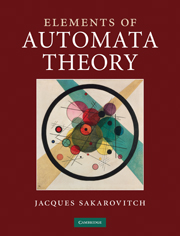V - THE SIMPLICITY OF FUNCTIONAL TRANSDUCERS
from Rationality in relations
Published online by Cambridge University Press: 05 September 2013
Summary
As announced in the last chapter, this chapter deals with functional relations, or functions, which can be realised by finite automata, and which, by habit and for convenience, and despite some confusion with other areas of mathematics, we shall call rational functions. The assumption of functionality combined with that of rationality will give remarkable structural results.
We start by proving that the fact of being functional is a decidable property for a rational relation. Then we define some families of functions that we will use in what follows, namely sequential (and co-sequential) functions, which are realised by transducers which, roughly, are to arbitrary functional transducers what deterministic (and co-deterministic) automata are to arbitrary automata.
The second section deals with the uniformisation of rational relations by rational functions. We deduce this result from the construction of a Schützenberger covering of an automaton, and this proof method will permit us to use it as the basis of all succeeding developments. In particular, we deduce simply that every every rational function has a semi-monomial matrix representation, which gives the principal structural result, namely that every rational function is the product of a sequential function and a co-sequential function, and it is this which allows us to say that rational functions ‘are simple’.
These results continue into the following section; first with the notion of the crosssection, which is dual to that of uniformisation, a reversal of the point of view which turns out to be fruitful. We continue with a closer and more technical study of the way in which uniformisations and cross-sections can be constructed.
- Type
- Chapter
- Information
- Elements of Automata Theory , pp. 643 - 738Publisher: Cambridge University PressPrint publication year: 2009



